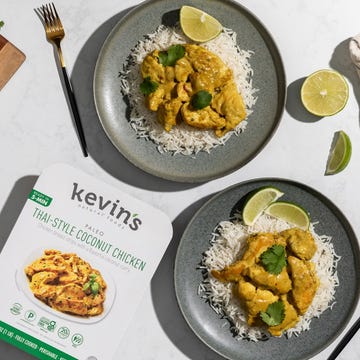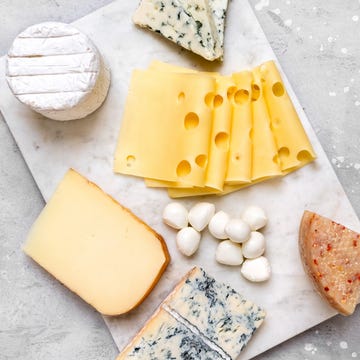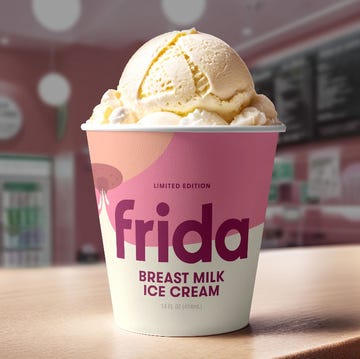On Wednesday, January 29, Robert F. Kennedy Jr’s confirmation hearings begin. The former presidential candidate and controversial “Make America Healthy Again” campaigner is President Donald Trump’s nomination for head of the Department of Health and Human Services—which means that he’d be overseeing major health agencies like the Center for Disease Control and Prevention (CDC) and the Food and Drug Administration (FDA) if approved by the Senate. But many of RFK's policies, like his promotion of raw milk, aren't backed by health experts—and could even be dangerous to the public.
In the past, RFK has said he "only drinks" raw milk, and he’s not the only one. Gwyneth Paltrow adds raw cream to her coffee every morning. (FYI: Her purveyor for raw milk has been linked to at least 165 salmonella cases, the largest outbreak in the U.S. in over a decade.) And trad-wife influencers like Hannah Neeleman (@ballerinafarm) portray this risky dairy product as a wholesome, homesteader choice.
Raw milk isn’t currently legal everywhere. Those who don’t live in sanctioned states are securing their supply in more suspect ways. In New York State, for example, it’s illegal to sell raw milk beyond farm premises. (In 1987, the FDA prohibited the sale of the stuff across state lines.)
One source (who asked to remain anonymous for this story), says she buys contraband raw milk in Brooklyn. The seller pulls up in an unmarked insulated van in one of the wealthiest neighborhoods in the borough, where a throng of thirsty people wait for him. After cash changes hands, he dispenses raw milk so thick, you could scoop it from the plastic deli containers it's packed in.
That could become something of the past, though. In late October, before he was formally nominated, RFK shared his vision for the future of public health on X (formerly Twitter), writing, "FDA’s war on public health is about to end. This includes its aggressive suppression of psychedelics, peptides, stem cells, raw milk, hyperbaric therapies, chelating compounds, ivermectin, hydroxychloroquine, vitamins, clean foods, sunshine, exercise, nutraceuticals and anything else that advances human health and can't be patented by Pharma."
But raw milk (among other things) isn't safe—in fact, health experts are begging people not to drink it. Here's what “raw” means and why it's not advisable to consume unpasteurized milk.
Meet the Experts: Darin Detwiler, LPD, is an associate teaching professor of food policy at Northeastern University and author of Food Safety: Past, Present, and Predictions. Maya Feller, MS, RD, CDN of Brooklyn-based Maya Feller Nutrition is a registered dietitian nutritionist and author of Eating from Our Roots: 80+ Healthy Home-Cooked Favorites from Cultures Around the World and co-host of Slate’s Well, Now Podcast.
What is raw milk?
Raw milk is unpasteurized milk. It comes straight from the animal—usually cows, sheep, or goats, and less commonly, camels or donkeys. The milk is “raw” in that it hasn’t been pasteurized (heated to kill the germs) like the milk you find at the grocery store, which is required to go through the pasteurization process, per FDA regulations.
Why is this distinction important? “Pasteurized milk removes harmful germs and bacteria through a process where the milk is heated to a specific temperature,” according to Maya Feller, RD, the founder and lead dietitian at Maya Feller Nutrition. “This reduces the risk of foodborne illness.”
What is pasteurization?
Pasteurization is a way of extending the shelf life of food by using heat to kill the harmful bacteria. Humanity owes a big merci to the French scientist Louis Pasteur, who made this eponymous discovery in 1864. Thanks to his invention, people can enjoy foods like dairy, packaged juice, deli meats, wine, beer, and kombucha without them spoiling right away. It has been used by American dairy farms on a large scale since 1947.
The most common method of pasteurization in the United States today is High Temperature Short Time (HTST) pasteurization, according to the International Dairy Foods Association. This process uses metal plates and hot water to raise the temperature of milk to at least 161° F for no less than 15 seconds, followed by rapid cooling.
Before pasteurization was widely used, people were getting seriously ill with diseases linked to harmful bacteria found in milk (think: typhoid fever, scarlet fever, tuberculosis). Today, for every 2 billion servings of pasteurized milk or milk products consumed in the United States, only about one person gets sick, according to an FDA evaluation. Many studies have backed the health and safety of pasteurized milk.
Why is it unsafe to drink raw milk?
Television and the movies—and increasingly, social media—often portray milk straight from the cow as a wholesome, pure drink. But the realities of food hygiene paint a more sordid picture.
“Raw milk and its products pose a tangible risk to consumer health,” says Darin Detwiler, LPD, an associate teaching professor of food policy at Northeastern University and author of Food Safety: Past, Present, and Predictions. “That’s why many health organizations and food safety experts advocate for pasteurization as a crucial step in ensuring safe consumption.”
But how big is the risk? Are we talking about a tummy ache or something more serious? Detwiler says the risks are unequivocally significant. Though raw milk consumers make up a small portion of the population (about three percent in 2017), compared to their pasteurized-milk-drinking counterparts, they are 838 times more likely to get sick and 45 times more likely to be hospitalized, according to a study in Emerging Infectious Diseases.
“Raw milk can contain dangerous microorganisms such as Salmonella, E. coli, and Listeria, which can cause severe foodborne illnesses,” he says. This means that if you consume contaminated raw milk, the effects can be much worse than an upset stomach.
Think: Body aches, severe gastrointestinal distress, fever, vomiting, and diarrhea, according to Detwiler. In some cases, illnesses caused by raw milk can result in long-term and life-threatening health complications, such as kidney damage or failure, Guillain-Barré syndrome (which can lead to paralysis), neurological disorders, stroke, and sepsis.
Bovine tuberculosis, which is spread from raw milk, can require up to a year of antibiotics to fully cure. In some cases, illness from food pathogens can result in hospitalization or death.
Detwiler knew a family whose toddler-age daughter got sick from a pathogen found in her raw milk. The girl was hospitalized and did survive—however, “she now will never walk, talk, or experience the same quality of life that she would have had she not become sick from unpasteurized milk,” he says.
Can you get bird flu from raw milk?
While raw milk is never a good idea, right now is a particularly bad time to take the risk. As bird flu cases continue to rise across the US, there are even more potential pathogens threatening the milk supply.
“While bird flu (avian influenza) is primarily associated with poultry, the potential for cross-contamination in dairy operations, especially those that do not follow strict biosecurity measures, cannot be overlooked,” Detwiler says. Bird flu viruses can survive in various environments and might contaminate water, feed, or equipment used in dairy farms, he adds. Plus, the virus itself can infect cows. Sixteen states have bird flu outbreaks in dairy cows today, per the CDC.
“Although the direct risk of bird flu through raw milk is lower compared to other bacterial pathogens, it's crucial to maintain rigorous hygiene practices in all aspects of food production to prevent the spread of any infectious agents, including bird flu,” he says.
Feller agrees. “Currently, the CDC specifically advises against raw milk consumption as there are increased risk with the Bird Flu A(H5N1) that can spread and has caused outbreaks in poultry and dairy cows.” Pasteurized milk doesn’t have the same problem. The pasteurization process is able to kill multiple strains of influenza (including H5N1), according to a 2024 study in Emerging Microbes and Infections.
How common is tuberculosis from raw milk?
It’s not just bird flu. We’re also seeing an unprecedented tuberculosis outbreak in the United States right now that could also make drinking raw milk just that much riskier. M. bovis—a.k.a. the bacteria that causes tuberculosis in cows—has frequently been isolated from unpasteurized milk samples, according to a 2022 study in BMC Public Health. And, in countries where raw milk is commonly consumed, researchers estimate that 10 to 15 percent of all human tuberculosis cases are caused by the bacteria.
Are there any benefits to raw milk?
The risks associated with unpasteurized milk sound pretty horrific—so why does it seemingly have so many proponents? Some advocates say that pasteurization ruins the flavor of milk and that the raw version tastes richer, sweeter, and creamier. It’s not dissimilar to tasting fresh-squeezed juice versus the stuff out of a carton at the supermarket.
Among some raw milk obsessives, there’s also a belief that this unprocessed form of milk is more nutritious, easier to digest, and good for gut health. Many of them believe it's better for you than pasteurized milk, particularly in helping to prevent allergies and ailments such as asthma and eczema. But is there any truth behind raw milk's health halo?
“There is some research looking at the nutritional quality of raw milk,” says Feller. “Preclinical animal studies have found that mice who were sensitized to raw milk have fewer allergic symptoms in comparison to mice that were sensitized to pasteurized milk.”
She cautions that further research, specifically human studies, are needed to substantiate the claims that raw milk helps with allergies and is easier to digest for people who are lactose intolerant. “Pasteurization is important for people who are immune-compromised, and the process is known to reduce the risk of foodborne illness significantly for the general population,” she says.
Does pasteurized milk have the same nutritional benefits as raw milk?
"Raw milk and pasteurized milk have similar nutritional values,” says Feller. “Some water-soluble vitamins, B1, B2, B12, vitamin C, and folate, decrease during pasteurization; however, these vitamins were not present in significant amounts prior to pasteurization.”
How much raw milk must be consumed to be a real risk?
If you’re curious about how it tastes, can you just have a thimbleful of raw milk and be okay?
“The amount of raw milk (or of any contaminated food) required to pose a health risk is not easily quantifiable,” Detwiler says. “Even a small amount can contain enough pathogens to cause illness, depending on the contamination level and the individual's susceptibility.”
So no, even a thimbleful of raw milk can expose you to harmful bacteria, and there is no safe threshold that guarantees you won't get sick.
His advice? Just don’t drink it. “Consuming any amount of raw milk is considered risky and not recommended by food safety experts.”
Is it just the elderly and children who are at risk?
A contaminated batch of raw milk can infect anyone. “While children, the elderly, pregnant women, and individuals with weakened immune systems are at higher risk of severe illness from consuming raw milk, even healthy adults are not immune to the dangers,” he says.
Healthy individuals can still contract serious infections, which can lead to severe symptoms and long-term health consequences. “Foodborne pathogens do not discriminate, and raw milk can cause illness in anyone, regardless of their age or health status,” he says.
What if I bought the raw milk from a very good dairy farm that I trust?
“Buying raw milk from a reputable farm with good hygiene practices may reduce the risk of contamination, but it does not eliminate it,” Detwiler says. “Even well-managed farms can have bacteria present in the environment, equipment, or from the cows themselves.”
Pathogens can be introduced during milking, handling, or storage, and the absence of pasteurization means there’s no kill step to eliminate them.
“Trust in the farm’s reputation does not equate to a guarantee of safety when it comes to raw milk,” he says.
What if I heated raw milk? Would it be safe to drink?
Pasteurization involves heating milk to a specific temperature (at least 161°F) for a set amount of time (15 seconds) to effectively kill pathogens, so unless you’re meeting that very specific standard, your milk probably isn’t in the clear. “Simply warming milk at home typically does not meet these conditions and may not eliminate all the dangerous microorganisms,” Detwiler says. And, BTW, heating milk sufficient to froth it for a latte definitely doesn’t do it.
What about dairy products made from raw milk (e.g., yogurt, butter, or cheese)—are these safe to consume?
“They can still pose risks unless they have been aged or treated to kill bacteria,” says Detwiler. “While some cheeses made from raw milk undergo processes that reduce bacterial risks, it is generally recommended to avoid consuming any raw milk products to minimize the risk of foodborne illness.”
Need any more convincing? “I do not recommend that my patients consume raw milk,” Feller says.
Susan (she/her) is the recipe editor at Good Housekeeping, where she pitches ideas, parses words, and produces food content. In the Test Kitchen, she cooks (and samples!) recipes, working with developers to deliver the best written versions possible. A graduate of Brown University and a collaborator on several cookbooks, her previous experience includes stints at Food & Wine, Food Network, three meal kit companies, a wine shop in Brooklyn and Chez Panisse, the pioneering restaurant in Berkeley, California. She enjoys playing tennis, natural wines and reality competition shows.
Olivia Luppino is an editorial assistant at Women’s Health. She spends most of her time interviewing expert sources about the latest fitness trends, nutrition tips, and practical advice for living a healthier life. Olivia previously wrote for New York Magazine’s The Cut, PS (formerly POPSUGAR), and Salon, where she also did on-camera interviews with celebrity guests. She’s currently training for her first half marathon, inspired by her many colleagues at WH who have run one.













